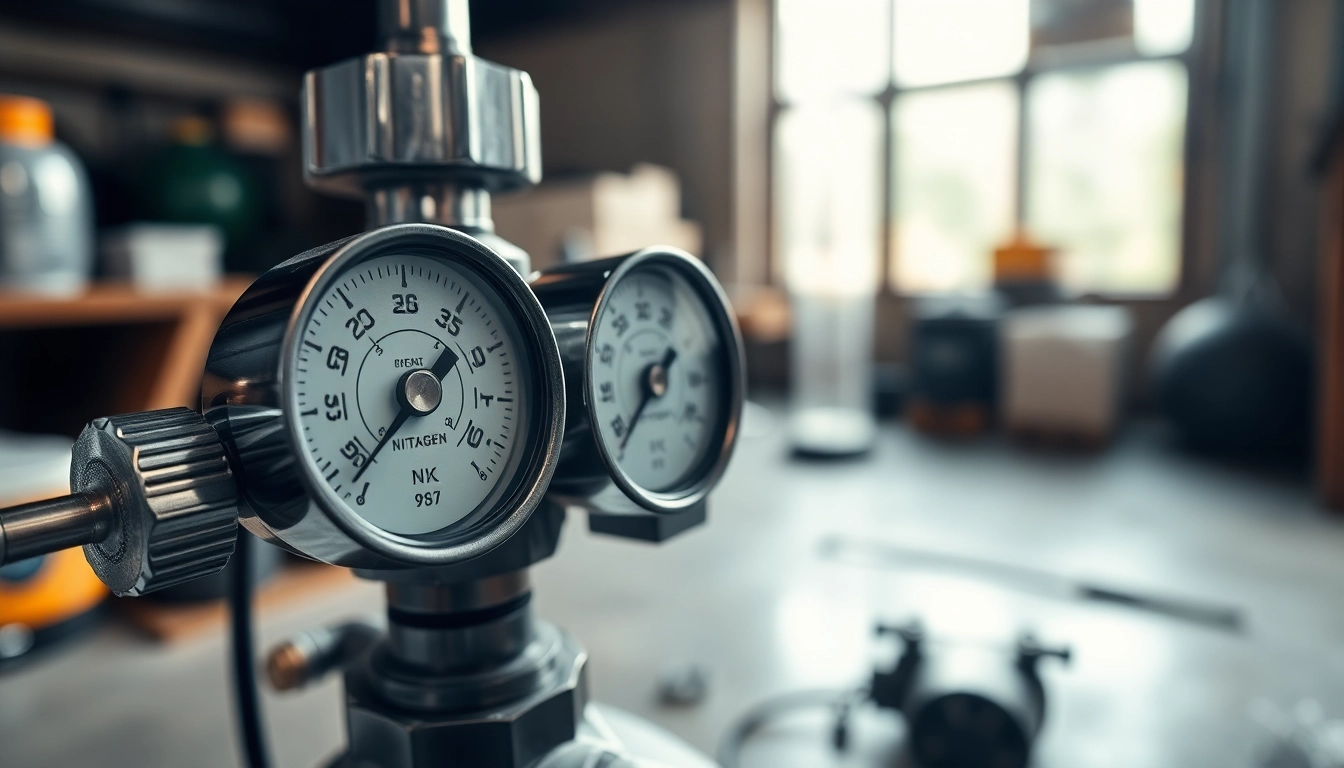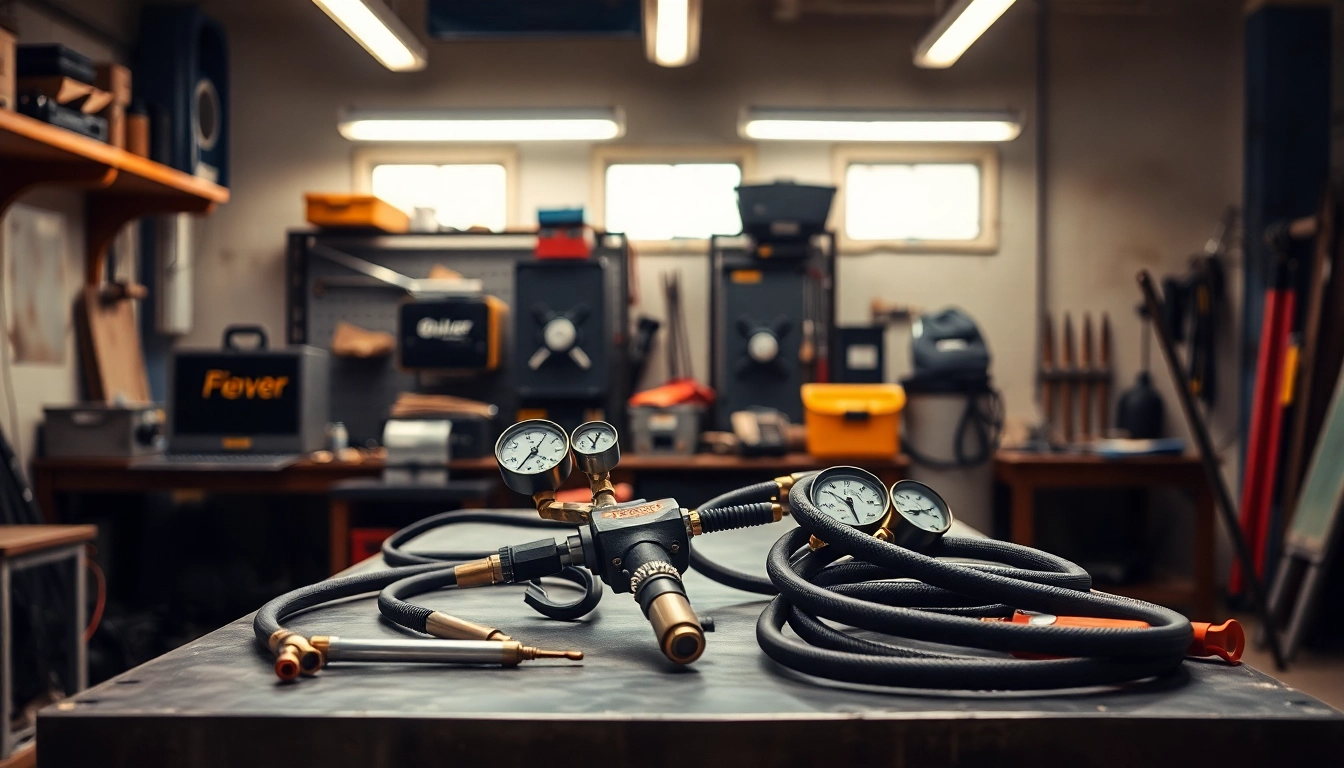Understanding Nitrogen Regulators
What is a Nitrogen Regulator?
A nitrogen regulator is a crucial component in any system where controlled delivery of nitrogen gas is required. It serves the primary function of regulating the pressure from nitrogen cylinders and ensures that the gas is delivered at a consistent and safe pressure. By modulating the high-pressure gas from a cylinder, nitrogen regulators are invaluable in diverse applications ranging from food packaging, where they help to preserve freshness, to industrial applications such as purging tanks and pressurizing system components.
Typically, a nitrogen regulator features two pressure gauges: one for cylinder pressure and another for outlet pressure. Users can choose between adjustable or preset regulators, depending on the specific application requirements. For a comprehensive overview of nitrogen regulators and their applications, you can visit nitrogen regulator resources.
How Do Nitrogen Regulators Work?
Nitrogen regulators operate using a system of springs and diaphragms. When the high-pressure nitrogen gas enters the regulator from the cylinder, it pushes against the diaphragm. This diaphragm then moves to adjust the flow of gas exiting the regulator. The output pressure can be fine-tuned depending on the application needs. For instance, in processes requiring a low pressure for gas purging, the regulator can be set or adjusted to a lower PSI.
This mechanism ensures that users obtain the desired pressure levels steadily without the risk of fluctuations that could lead to equipment damage or inefficiencies in the intended process. Consequently, understanding the working principle of a nitrogen regulator is essential in optimizing its performance in various settings.
Common Applications of Nitrogen Regulators
Nitrogen regulators find usage in various industries, each with specific applications:
- Food and Beverage: In food packaging, nitrogen helps displace oxygen to prevent spoilage, and regulators are used to maintain appropriate pressure during the packaging process.
- HVAC Systems: Nitrogen is utilized in refrigeration systems for leak testing and pressure testing. Regulators adjust the nitrogen flow necessary for maintenance operations.
- Aerospace and Automotive: Nitrogen is used for purging and pressurizing fuel systems, requiring precise control delivered by appropriate regulators.
- Welding: In the welding sector, nitrogen regulators control the flow of gas during gas shielded welding processes.
Types of Nitrogen Regulators
Single vs. Dual Outlet Nitrogen Regulators
Nitrogen regulators can be categorized based on the number of outlets they possess. Single outlet nitrogen regulators are straightforward devices used to deliver nitrogen from a single source to one application, whereas dual outlet regulators provide flexibility by allowing nitrogen to be distributed simultaneously to multiple applications.
The choice between single and dual outlet regulators should be dictated by operational needs. A single outlet is typically adequate for most standard applications, while dual outlet regulators are beneficial for setups like nitrogen leak testing of multiple tanks or systems that require simultaneous nitrogen purge while maintaining a specific flow to another application.
Adjustable vs. Preset Nitrogen Regulators
Another significant distinction in nitrogen regulators is between adjustable and preset types. Adjustable nitrogen regulators allow users to set the outlet pressure according to fixed needs usually through a rotating knob, offering versatility for different applications. In contrast, preset regulators come with factory-set pressure limits and cannot be altered, making them suitable for applications requiring stringent pressure control where variable changes are unnecessary.
When deciding between the two types, consider the requirements of your nitrogen application, weighing the need for flexibility against the necessity for consistent, precise delivery.
Specialized Nitrogen Regulators for Different Industries
Several industries require specialized nitrogen regulators tailored to their unique needs. For example:
- Medical: Medical-grade nitrogen regulators are designed to ensure the safe delivery of nitrogen for various applications such as pneumatic tools used in surgeries.
- Chemical Processing: These regulators are built to handle corrosive environments where standard regulators might not suffice.
- Construction: Heavy-duty nitrogen regulators are utilized for pressure testing of newly installed piping and equipment to ensure safety and compliance.
Choosing the Right Nitrogen Regulator
Factors to Consider When Selecting a Nitrogen Regulator
Selecting the right nitrogen regulator involves multiple considerations. Here are critical factors to weigh:
- Application Requirements: Identify the specific needs of your application, including flow rate and pressure demands.
- Compatibility: Ensure compatibility between your nitrogen source and the regulator, particularly with outlet sizes and pressure ratings.
- Material Construction: Consider the materials used in the regulator to ensure it can withstand the operating environment.
Brand Comparisons: High-Pressure vs. Low-Pressure Models
Understanding the distinction between high-pressure and low-pressure nitrogen regulators is crucial for selecting the right model for your needs. High-pressure regulators are essential for industries utilizing gas at pressures above 200 PSI, while low-pressure models adequately serve applications operating below this threshold.
Popular brands such as WT Farley offer a range of models that cater to both high and low-pressure requirements, helping you make informed choices based on application specifics.
Understanding PSI Ratings and Their Importance
The pressure rating, expressed in pounds per square inch (PSI), indicates the maximum pressure a regulator can handle. When choosing a nitrogen regulator, it is essential to match the PSI rating with the operational requirements. Mismatched pressure ratings can lead to inefficient operation, reduced safety, and damage to equipment. Hence, a thorough understanding of applicable PSI ratings ensures optimal performance and longevity of your systems.
Best Practices for Using Nitrogen Regulators
Safety Guidelines When Operating Nitrogen Regulators
Safety is paramount when it comes to operating nitrogen regulators. Here are key safety guidelines to consider:
- Regular Inspections: Regularly check for gas leaks, signs of wear, or any damages to the regulator.
- Protective Gear: Use appropriate personal protective equipment (PPE) such as gloves and safety goggles when working with nitrogen.
- Follow Manufacturer Instructions: Adhere strictly to the guidelines provided by the manufacturer regarding pressure settings and operational procedures.
Maintenance Tips to Ensure Longevity
Proper maintenance is key to ensure the longevity of nitrogen regulators. Here are essential maintenance tips:
- Clean Regularly: Remove any debris or contaminants that might affect performance.
- Check Seals and Connections: Regularly inspect seals for signs of wear and replace them if necessary.
- Calibrate Periodically: Calibration ensures that the regulator continues to function within the prescribed limits.
Common Pitfalls and How to Avoid Them
Several common pitfalls can impact the functionality and safety of nitrogen regulators. Some of these include:
- Mismatched Components: Using adapters or connections that are incompatible with the regulator can lead to failure. Always ensure all components are designed to work together.
- Neglecting Regular Maintenance: As with any equipment, neglect of regular checks and maintenance can lead to unexpected failures. Set a schedule to maintain your regulators.
- Improper Settings: Users should be mindful of pressure settings. Too high a pressure can lead to equipment damage, while too low pressure can result in inadequate performance.
Performance Metrics for Nitrogen Regulators
Evaluating the Efficiency of Nitrogen Regulators
Measuring the efficiency of nitrogen regulators entails understanding various performance metrics, including flow capacity, pressure drop across the regulator, and leakage rates. Regulators should be evaluated based on their ability to maintain consistent outlet pressure while allowing efficient gas flow. Efficiency tests can reveal whether the regulator meets the specifications provided by the manufacturer and can handle the demands of specific applications.
Customer Feedback and Case Studies
Examining customer feedback can provide valuable insights into the performance of nitrogen regulators in real-world applications. Case studies highlighting successful implementations are particularly beneficial. For instance, a case study might detail how a high-pressure nitrogen regulator was instrumental in improving workflow efficiency in an HVAC system, showing reduced downtime and cost savings.
Future Trends in Nitrogen Regulation Technology
As technology evolves, so do the capabilities of nitrogen regulators. Trends indicate increased integration of smart technology, allowing remote monitoring and real-time adjustments of pressure settings. This advancement can enhance efficiency and safety in nitrogen deployment across various industries. Companies are likely to seek innovations that offer greater precision, enhanced safety features, and improved durability, driving the evolution of nitrogen regulation technologies into the future.



